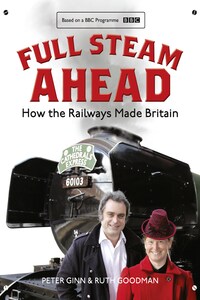William Collins
An imprint of HarperCollinsPublishers 1 London Bridge Street London SE1 9GF
WilliamCollinsBooks.com
This eBook edition published by William Collins in 2016
© Lion Television Limited, 2016
Photographs © individual copyright holders
Design and layout © HarperCollins Publishers 2016
By arrangement with the BBC.
The BBC logo is a trademark of the British Broadcasting Corporation and is used under licence.
BBC logo © BBC 1996
The authors assert their moral right to be identified as the authors of this work.
Full Steam Ahead was produced by Lion Television (an All3 Media company) for the BBC in partnership with the Open University.
Cover photograph © Stuart Elliot/Lion TV with permission from the National Railway Museum.
A catalogue record for this book is available from the British Library.
All rights reserved under International and Pan-American Copyright Conventions. By payment of the required fees, you have been granted the non-exclusive, non-transferable right to access and read the text of this eBook on-screen. No part of this text may be reproduced, transmitted, downloaded, decompiled, reverse engineered, or stored in or introduced into any information storage and retrieval system, in any form or by any means, whether electronic or mechanical, now known or hereinafter invented, without the express written permission of HarperCollins Publishers.
Source ISBN: 9780008194314
eBook Edition © July 2016 ISBN: 9780008194321
Version: 2016-07-26
The Victorian era was a period of immense change in Britain. It saw both the flowering and culmination of the agricultural and industrial revolutions, huge social reforms and massive technological advancements. The greatest of these was almost certainly the steam railway.
The railways changed the world. This is a bold statement, but it is unquestionably true. How scientific advancement comes about and the impact it has upon society is a complex issue. We often view our history in segments that are allocated according to the lifespans of rulers – for example, ‘the Victorian era’. However, the simple fact is that we are all part of a human race that ebbs and flows as it develops and changes over an indeterminate period of time – and this process is impossible to comprehend completely as it is happening. To divide history up into segments is one step towards trying to understand it. The timeframe of the birth of the steam railways, and their subsequent development and decline, is akin to the lifespan of a human being. Therefore, the age of the steam railways is a good lens through which we can study the nineteenth and twentieth centuries.
Unlike most rulers whom periods of time are named after, the steam railways dramatically changed our lives and the lives of our ancestors. The world was already becoming a smaller place. To paraphrase Roald Dahl, at the time of the advent of the railways, there were only a couple of pages in the atlas left to fill in. The idea of using steam power was not new, but the creation of an effective engine that could convert energy into work was most certainly a massive innovation. The first steam engines had a major impact. They were big and heavy, but within reason they could be situated anywhere. Once in place, the steam engines provided power, thus reducing the need for labour. They found their calling in some factories, in agriculture and in mining.
Furthermore, railways were not a new concept. Throughout history, there has been archaeological evidence that indicates the use of trackways in various parts of the world. Also, the concept of wheels running on steel rails is not too dissimilar to that of boats travelling on canal water, when it is broken down to a basic mathematical level. Both methods of transportation reduce friction, allowing heavier loads to be pulled using less force. Just like the steam engines that pumped water out of mines, horse-drawn railways moved material from the very same mines down to the ports. However, it was the successful marriage of these two concepts that changed the world.
The Victorians were unstoppable innovators, and their era was marked by massive industrial and technological development. This is the giant waterwheel at Laxey, Isle of Man, constructed by the Casement firm in 1854.
The presenters of Full Steam Ahead, historians Peter Ginn, Ruth Goodman and Alex Langlands, about to board the preserved steam engine, 60103 The Cathedrals Express.
FULL STEAM AHEAD
In the nineteenth century, the term ‘locomotive engine’ was first used to distinguish a steam-powered engine that could move forwards and backwards from a completely static engine that merely provided power. Once the idea of a








